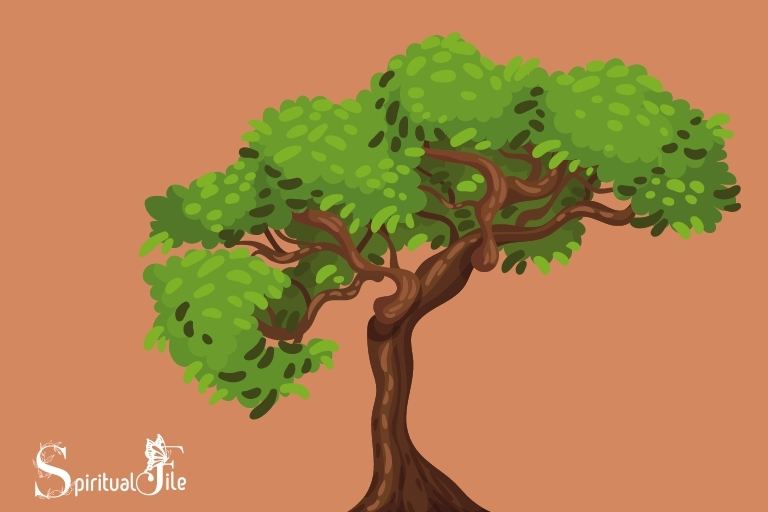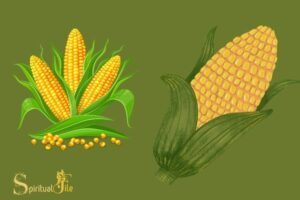What Does a Tree Represent Spiritually: Protection!
A tree represents spiritual growth, strength, protection, and connectedness in various cultures and belief systems.
In many spiritual traditions, trees are seen as symbols of wisdom, life, and interconnectedness with nature and each other.
They provide shelter, nourishment, and life-giving resources, mirroring the nurturing and supportive qualities of a spiritual journey.
Trees also have deep roots and tall branches, signifying the link between the earthly and spiritual realms.
Throughout history, trees have been revered for their spiritual significance and connection to the divine. For example, the Bodhi tree in Buddhism is associated with the enlightening moment of Buddha.
In Christianity, the Tree of Life represents eternal life and the connection between God and humanity. The Yggdrasil in Norse mythology is an immense tree connecting the nine worlds.
This reverence for trees showcases the deep-rooted symbolism of trees within our collective spiritual consciousness.
7 Spiritual Meaning of Trees
| Tree Symbolism | Spiritual Meaning | Examples |
|---|---|---|
| Growth | Personal growth, development, and self-improvement | The Tree of Life in various religions and philosophies |
| Connection | Connection between heaven and earth, as well as between family and ancestors | The World Tree in Norse mythology (Yggdrasil) |
| Strength | Resilience, perseverance, and inner strength | The Oak tree in Celtic mythology, symbolizing strength and longevity |
| Wisdom | Knowledge, understanding, and learning from experience | The Bodhi Tree, under which Buddha gained enlightenment |
| Nourishment | Providing sustenance and shelter for oneself and others | The ancient Greek myth of the nymph Daphne, who turned into a laurel tree |
| Renewal | Transformation, renewal, and the cycle of life | Trees shedding their leaves in the fall and sprouting new growth in the spring |
| Balance | Maintaining balance between opposing forces, such as light and darkness or life and death | The concept of the Tree of Knowledge of Good and Evil in Christianity |
Key Takeaway

Five Facts About: Spiritual Meaning of Trees
The Roots Of Tree Meanings In Myth And Religion
Trees have always held a special place in human history, myth, and religion. Throughout time, different cultures have ascribed various meanings to trees, making them into powerful symbolic tools to convey ideas and beliefs.
Let’s take a closer look at the cultural significance of trees throughout history, as well as the different ways in which they have been used to represent spiritual concepts.
Cultural Significance Of Trees Throughout History
Over the centuries, trees have taken on a wide range of meanings, depending on where and when they were used.
Here are some of the most common ways in which different cultures throughout history have viewed trees:
- Trees have often been seen as symbols of fertility, renewal, and growth. In many cultures, they have been used to represent the cycle of life, death, and rebirth, and have been seen as a source of strength and wisdom.
- In ancient Egyptian mythology, the sycamore tree was believed to be the tree of life, and was seen as a symbol of resurrection and immortality.
- In Norse mythology, the world tree yggdrasil represented the axis mundi, or the center of the universe, connecting the worlds of the living, the dead, and the gods.
- In Celtic mythology, the oak tree was revered as a symbol of strength, endurance, and wisdom, and was often associated with the sacred druids.
- In Hinduism, the banyan tree was seen as a symbol of eternal life, and was believed to be a manifestation of the god vishnu.
- In christianity, the tree of the knowledge of good and evil in the garden of eden has been interpreted in a variety of ways, representing both the fall of man and the possibility of redemption.
Trees As Symbols Of Fertility, Renewal And Creation Myths
Perhaps the most common symbolic role of trees in mythology and religion is that of representing fertility, renewal, and creation myths.
Here are some of the key points to keep in mind if we look at trees from this perspective:
- Many myths and religions use the tree as a symbol of the divine birth or creation stories. For instance, in norse mythology, odin created the first man and woman out of two trees, while in hinduism, the world is said to have grown out of the cosmic banyan tree.
- Trees have also been associated with renewal, growth, and creativity. This is why many cultures use them as part of rituals and ceremonies meant to celebrate the changing of the seasons, or to welcome the arrival of a new year.
- In some cultures, trees are seen as amplifiers of life force energy or chi, determining a person’s general level of health and well-being. This is why in traditional chinese medicine, certain trees are believed to carry special healing properties that can help restore balance to the body and mind.
Trees As Metaphors For Human Life And Experience
Tree Symbolism In Literature And Art
Throughout history, trees have featured in numerous works of art and literature.
From william wordsworth’s famous poem “i wandered lonely as a cloud” to the iconic scene in “the lion king” where rafiki presents simba as the new king under a majestic baobab tree, trees have been used as symbols of growth, strength, and stability.
- In literature, trees are often used to represent life or growth. They can be seen as a metaphor for the journey of human life, from birth to death and beyond.
- In art, trees can represent the natural beauty of the world. They are often depicted to symbolize an abundance of life and growth, or to demonstrate calm and tranquility.
Tree As A Mirror Of Human Emotions
Trees also provide a reflection of the human experience. Just as trees experience different seasons of growth and decay, humans go through different phases in life and experience a range of emotions.
- Trees can reflect human emotions, such as joy, sorrow, and restlessness. For instance, a blossoming tree can be seen as a representation of happiness, while a barren tree can represent sadness or loneliness.
- Trees can also portray stillness and peace, serving as a reminder to pause and reflect. Often, people find solace in nature, and trees can be an excellent symbol of comfort during challenging times.
A Closer Look At Various Tree Species And Their Significance
Each tree species carries its significance and unique symbolism.
- Oak trees: These can represent strength, courage, and wisdom. In celtic mythology, the oak was seen as a doorway to the “otherworld”, making it a symbol of spiritual growth and enlightenment.
- Olive trees: These can symbolize peace, fertility and hope. In greek mythology, athena created an olive tree, making it a symbol of peace and protection.
- Cherry blossom trees: These represent beauty, fragility, and the transience of life. The blooming of cherry blossoms is widely celebrated in japan as a symbol of the fleeting nature of beauty and life.
- Pine trees: These symbolize persistence, longevity, and resilience. They have been used in Japanese culture as a symbol of personal growth and enlightenment.
- Baobab trees: These can represent strength, resilience and community. They are known for their ability to store large volumes of water, making them a symbol of hope in times of drought.
Trees have different meanings and interpretations in different cultures and art forms. They represent everything from strength and resilience to growth, peace, and hope.
Understanding the various symbols and meanings of trees can provide insight into the human experience and inspire us to be mindful of our emotional and spiritual growth.
The Healing Power Of Trees
Trees are a vital part of the ecosystem, providing numerous benefits both spiritually and physically.
We will explore the healing power of trees, including their aromatherapy and medicinal benefits, as well as scientific evidence supporting their use in promoting good health.
Aromatherapy And Healing Benefits Of Tree Oils
Essential oils derived from trees can provide multiple health benefits.
Here are a few examples:
- Eucalyptus oil: Helps in clearing the airways and congestion, providing relief during cold and flu seasons.
- Pine oil: Reduces stress and anxiety with its calming scent.
- Tea tree oil: Has antibacterial and anti-inflammatory properties, making it an effective treatment for skin conditions such as acne and eczema.
- Cedarwood oil: Promotes relaxation, improves sleep, and reduces tension in the muscles.
Traditional Medicinal Uses Of Trees
For centuries, different cultures have used various parts of the tree for medicinal purposes.
Some examples are:
- Willow bark: Has anti-inflammatory properties and is effective in reducing pain and fever.
- Elderberry: Is used in traditional medicine to combat respiratory issues such as coughs, colds, and flu.
- Turmeric: The root of the curcuma longa plant has anti-inflammatory properties and is used to treat digestive problems and inflammatory conditions.
The Scientific Evidence Of The Health Benefits Of Trees
There is an increasing body of scientific evidence supporting the health benefits of trees.
For instance:
- Spending time in natural surroundings, including forests, can reduce stress hormones, improve mood, and boost the immune system.
- Trees absorb pollutants, improving air quality and reducing respiratory diseases.
- A study published in the american journal of preventive medicine found that people living in areas with more trees have fewer cases of heart disease and other chronic diseases.
Trees are not only aesthetically pleasing and spiritually significant, but their benefits for health and well-being are undeniable.
From their aromatherapy and healing benefits to their traditional medicinal uses and scientific evidence of promoting good health, trees are truly a gift to humanity.
Trees And Nature Spirituality
Trees symbolize various spiritual meanings in different cultures worldwide. In many belief systems, trees represent diverse concepts such as strength, growth, and resilience.
The spiritual significance of trees is essential in paganism and wiccan spirituality as they recognize nature as an embodiment of divine spirits.
The Role Of Trees In Pagan And Wiccan Spirituality
In pagan and wiccan spirituality, trees are regarded as sacred spaces that offer protection and spiritual energy.
They believe that trees are gateways to other worlds and that each tree has a unique spirit that can offer guidance to humans.
Some of the specific roles of trees in pagan and wiccan spirituality are:
- Acting as a medium between the physical and spiritual realms
- Providing a center for meditation and rituals
- Representing spiritual growth and change
How Trees Can Be Used In Meditation And Mindfulness Practices
Trees are considered ideal for meditation and mindfulness practices as they provide a tranquil environment to calm the mind.
Trees’ stillness and stability, coupled with their soothing presence, can aid in reducing stress and anxiety levels.
Here are some ways trees can be used in meditation:
- Observe the pattern of the branches and leaves swaying in the breeze
- Listen to the rustling of leaves and the chirping of birds
- Focus on the flow of energy from the tree’s roots to the crown
The Connection Between Trees And Preservation Of Natural World
Trees are crucial in the preservation of the natural environment. The world’s forests are responsible for absorbing a significant amount of the carbon dioxide produced by human activities, helping to reduce the impact of climate change.
Additionally, trees provide a habitat for various species of wildlife, regulating the ecosystem and maintaining biodiversity.
Therefore, preserving trees and forests is essential for the survival of the planet and all living things.
Trees play a vital role in nature spirituality, meditation and mindfulness practices, and the preservation of the natural world.
Understanding their spiritual significance and importance in our daily lives is crucial to appreciating the wonders of nature.
How Does the Spiritual Symbolism of Sunflowers Compare to That of Trees?
The sunflower’s spiritual positivity representation is often associated with adoration, loyalty, and longevity. Meanwhile, trees signify strength, growth, and protection. Sunflowers tend to symbolize warmth and positivity, whereas trees are seen as grounding and rooted in wisdom. Both hold deep spiritual symbolism, but with distinct representations.
FAQ Of What Does A Tree Represent Spiritually
What Is The Spiritual Meaning Of A Tree?
Trees represent growth, stability, and interconnectedness with the earth and universe in many spiritual beliefs.
Can Trees Communicate With Each Other?
Yes, trees can communicate with each other through a network of fungi and chemical signals, known as the “wood-wide web. “
What Do Different Types Of Trees Symbolize?
Different types of trees symbolize various qualities and emotions, e. g. , pine symbolizes immortality, while willow represents emotions and intuition.
How Can I Connect With The Spiritual Energy Of A Tree?
You can connect with a tree’s spiritual energy by meditating near a tree and observing its energy or conducting a visualization exercise.
Is There A Specific Tree That Represents Spiritual Awakening?
The bodhi tree is a common symbol of spiritual awakening because it is where siddhartha gautama, the buddha, attained enlightenment.
Conclusion
Trees have always been a fascinating subject for spiritualists. Each tree has its unique story and lessons on life, strength, and endurance.
As we have learned from this article, the spiritual representation of trees differs from culture to culture. Trees symbolize growth, fertility, and protection.
They connect us to our roots and the planet we live in. Trees teach us to stand tall and endure every storm that comes our way.
They show us that life is full of changes, and we should learn to adapt and grow with them.
Regardless of our beliefs, we can all agree that trees are remarkable beings that deserve our respect, appreciation, and protection.
In our fast-paced world, it’s crucial to reconnect with nature and acknowledge the wisdom it has to share with us.
So, let’s take a moment to appreciate the beauty, power, and purpose of the trees around us.






